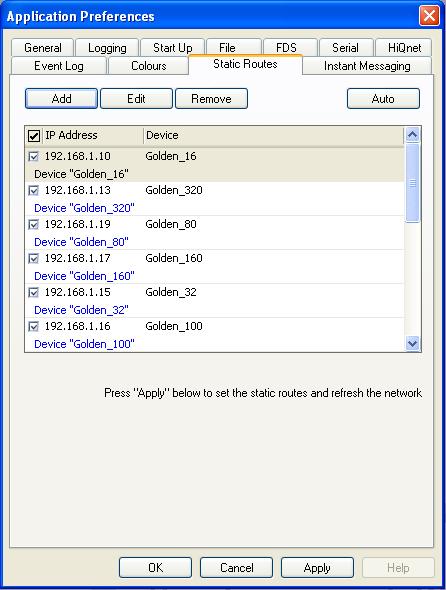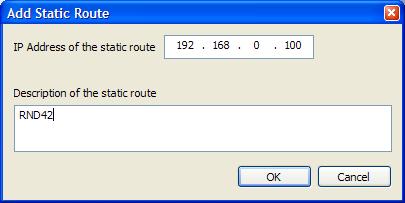Static routes can be set in Application Preferences as well as in File Preferences. Where a device is on a different subnet to the pc, it is possible to set up a static route to get a direct connection to that device. Since static routes which are set in file preferences are saved as part of the design file, it is not possible to open the design from the device network when it is on a different subnet. Setting static routes in Application Preferences allows you to 'see' the device in London Architect and then open the design from a device on the network which is on a different subnet. Where there is a conflict of IP addresses FIle Preferences will always take priority.

The table has three columns and an optional description. The columns are:
- Enable check box. A static route can be enabled and disabled.
- IP Address is the IP address of the remote device.
- Device column is not user editable, but shows the name of the device on the network if the static route is found.
The buttons do the following:
Add
Provides a pop-up dialog where a new route can be added. Enter the IP address of the remote device and an optional description here.

Edit
The Edit button shows the same dialog as Add but is filled with the selected routes values. The route can then be edited.
Remove
The Remove button allows the removal of one or more routes (the list of routes allows multiple select).
Auto
The Auto button will populate the static routes with the devices currently on the network. This will be useful prior to the use of VPN when an installer is on site and can add all devices in one go.
Apply
The Apply button applies any changes. When the changes are applied, the static routes are set up in the network stack, and the network view is refreshed. Discovery will start on any routes just added and the remote devices will appear in the network window. Newly added routes which have been discovered will add the name of the discovered devices in the "Device" column.
Note
Static routes create additional network traffic which may be undesirable on large networks.
The BLU-8 cannot control devices on remote subnets, the BLU-8v2 however, can control devices on remote subnets.